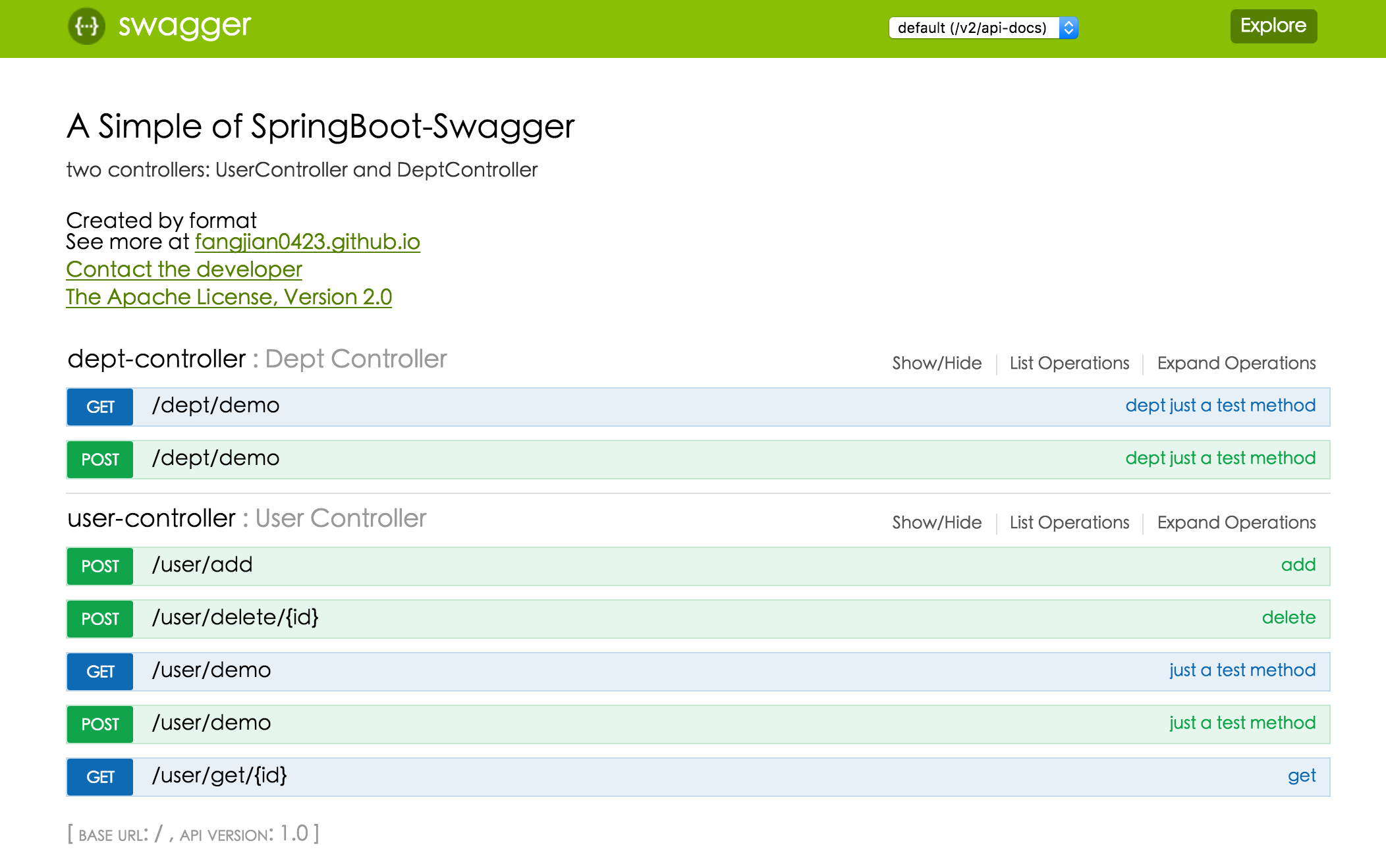Swagger是一个规范和完整的框架,用于生成、描述、调用和可视化 RESTful 风格的 Web 服务。
在SpringBoot中要使用Swagger的话,可以使用springfox。
在sbt中添加依赖即可:
libraryDependencies += "io.springfox" % "springfox-swagger2" % "2.6.0"
libraryDependencies += "io.springfox" % "springfox-swagger-ui" % "2.6.0"
查看springfox-swagger2中的源码,发现springfox并不是通过autoconfigure实现和swagger的整合的,而是基于Spring的方式Import各种bean构造Swagger。
所以本文指的Swagger在SpringBoot中的使用同样也可以在Spring中使用。
要整合Spring和Swagger的话需要这么做。
- 加上@EnableSwagger2注解
- 构造一个Docket
以下代码就是例子:
@EnableSwagger2
@Configuration
public class SwaggerConfiguration {
@Bean
public Docket userDocket() {
ApiInfo apiInfo = new ApiInfo("A Simple of SpringBoot-Swagger",// 大标题
"two controllers: UserController and DeptController",// 小标题
"1.0",// 版本
"NO terms of service",
new Contact("format", "fangjian0423.github.io", "fangjian0423@gmail.com"), // 作者信息
"The Apache License, Version 2.0",// 开源许可证
"http://www.apache.org/licenses/LICENSE-2.0.html"// 许可证详情
);
return new Docket(DocumentationType.SWAGGER_2)
.select()
.paths(Predicates.or(PathSelectors.regex("/user/.*"), PathSelectors.regex("/dept/.*")))
.build()
.apiInfo(apiInfo);
}
}
需要注意的是path方法表示要构造的url,这里使用了or连接了 /user/.** 和 /dept/.** 这2个地址,这里用的是正则的匹配方式。
UserController:
@RestController
@RequestMapping(Array("/user"))
class UserController {
@ApiOperation(nickname = "test method", value = "just a test method")
@RequestMapping(value = Array("/demo"), method = Array(RequestMethod.POST, RequestMethod.GET))
def demo(): String = {
"Hello Swagger"
}
@RequestMapping(value = Array("/get/{id}"), method = Array(RequestMethod.GET))
def get(@PathVariable id: String): String = {
s"get ${id}"
}
@RequestMapping(value = Array("/delete/{id}"), method = Array(RequestMethod.POST))
def delete(
@ApiParam(name = "id", value = "the identity of user", required = true)
@PathVariable id: String
): String = {
s"delete ${id}"
}
@ApiImplicitParams(
Array(
new ApiImplicitParam(name = "name", value = "the name of user", required = true, paramType = "form", dataType = "string"),
new ApiImplicitParam(name = "age", value = "the age of user", required = true, paramType = "form", dataType = "int")
)
)
@RequestMapping(value = Array("/add"), method = Array(RequestMethod.POST))
def add(req: HttpServletRequest): String = {
s"${req.getParameter("name")}-${req.getParameter("age")}"
}
}
Swagger默认会去找被@RequestMapping注解的方法。
@ApiOperation注解用于说明接口的作用,作用在方法上,如果没有使用这个注解,会去@RequestMapping中的value和method等属性。
@ApiParam注解用来额外说明参数的meta data。
@ApiImplicitParams注解也用来额外说明参数,当参数不在方法里声明的时候,可以使用这个注解。需要注意的是这个注解只能作用在方法上。
Swagger还提供了@ApiModel、@ApiResponse、@Example等诸多注解用于说明接口的作用。
另外一个Controller:
@RestController
@RequestMapping(Array("/dept"))
class DeptController {
@ApiOperation(nickname = "dept test method", value = "dept just a test method")
@RequestMapping(value = Array("/demo"), method = Array(RequestMethod.POST, RequestMethod.GET))
def demo(): String = {
"Hello Swagger"
}
}
Swagger展示如下:

